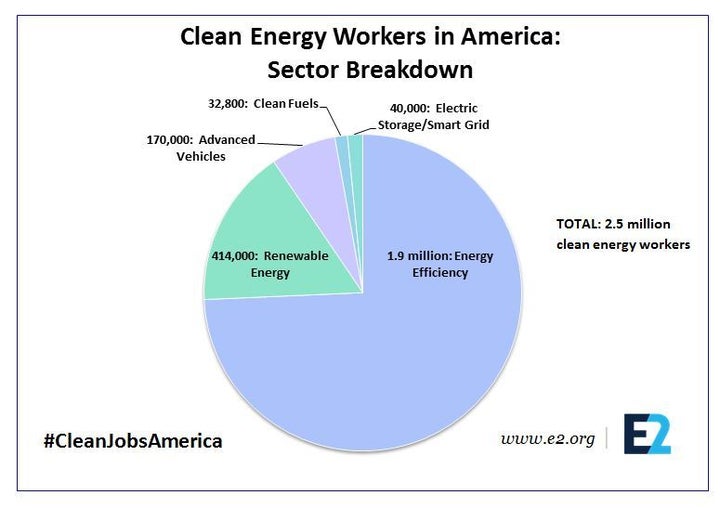
E2, a national nonpartisan group of business leaders, investors and others who advocate for smart energy policies, reports that 2.5 million Americans work in the clean energy sector. Its analysis was based on U.S. Bureau of Labor Statistics data and a survey of tens of thousands of businesses across the country. More information is available here.
If there was any doubt about Donald Trump’s vision for America’s energy future, it has been eliminated this week during the Administration’s flurry of speeches, meetings and news events on energy policy. The President’s “Energy Week” underscored his conviction that the virtually unfettered production of coal, oil and natural gas will give us energy independence, global energy dominance, and the ability to export lots of fossil fuels to other countries.
The week also made clear that Trump’s energy aspirations are outdated, unrealistic, out of synch with market forces, bad for America’s international standing and contrary to the wishes of the American people. If his energy agenda is implemented, the United States would not only be the biggest outlier in the international campaign to fight climate change; we would be a country with few constraints on its own carbon emissions and one of the world’s biggest profiteering merchants of carbon pollution.
Trump’s energy priorities have plenty of domestic downsides, too. Like President Obama, he advocates an “all of the above” energy policy, but it’s clear that clean and renewable energy, the preferred resources in a carbon constrained world, will be confined to the rumble seat in Trump’s fossil fuel juggernaut. This is no surprise. During his campaign, Trump called renewables a “big mistake” and “just an expensive way of making the tree-huggers feel good about themselves”.
Many Americans, public officials and business leaders do not agree. A new survey by Pew Research Center found that 83% of Americans say “increasing use of renewable energy resources is a top or important priority for the country’s energy policies.” A study issued two months ago by a coalition of organizations including Calvert Investments documented that 63% of America’s largest 100 companies have established renewable energy goals. “A growing number of companies are setting 100% renewable energy goals and science-based greenhouse gas reduction targets that align with the global goal of limiting temperature rise to below two degrees Celsius,” the study’s authors found.
Many states and cities, red and blue, are betting on renewable energy, including the 29 states with formal renewable energy goals. All five of the states that are most bullish on wind power are traditional Republican strongholds. Texas was the national leader in wind power last year. In Iowa, wind and solar power together contributed 37% of the state’s electricity. Wind and solar provided at least 20% of energy in six other states.
Another survey, released a couple of days ago by the U.S. Conference of Mayors, found that nearly 70% of the cities that responded already generate or purchase renewable electricity; 63% buy green vehicles for their fleets; and 66% have energy efficiency policies for their municipal buildings. At their annual conference this week, more than 250 mayors, Republicans and Democrats alike, adopted a resolution urging cities to obtain 100% of their energy from renewable resources by 2035. As a result of this rising market demand, wind and solar energy have just achieved a milestone: For the first time, they generated more than 10% of the nation’s electricity, still small but growing rapidly.
Trump’s desire for energy independence is nothing new; it has been a reliable political slogan since the oil crises of the 1970s. But his strategy to achieve independence is futile. “If we are going to become energy independent,” Trump has written, “we need to keep drilling.” In fact, the opposite is true. So long as the United States depends on oil, even domestic oil, we will be vulnerable to manipulation by other countries.
Energy analysts have pointed out repeatedly that oil prices and supplies are determined by the world petroleum market, not by individual nations. In the middle of our fracking boom last year, we were reminded about our vulnerability when OPEC decided to keep oil prices low. Oil wells shut down and there were widespread layoffs of U.S. oil workers. Even if we ended our oil addiction completely, significant oil shocks in other countries could have ripple effects in the United States — one reason we should export renewable energy technologies rather than oil and gas.
Fossil energy advocates point to the nation’s large reserves of fossil fuels, but their estimates do not ensure long-term energy security. There is a difference between how much oil, coal and gas is underground and how much we can technically, safely and profitably extract. As the coal sector discovered, rising competition from alternative sources of energy also can keep the reserves underground. Today, solar and wind have entered the competition with coal, gas and oil.
In short, the viable path to relative energy independence is an economy-wide transition to clean, inexhaustible and indigenous solar, wind, geothermal and hydroelectric energy, where “fuel” is readily available and free.
What about new jobs? An accurate assessment of coal’s history offers an important lesson. Mechanization and the shift to surface mining in places like Appalachia, combined lately with competition from natural gas, have been responsible for the substantial decline in coal jobs since early last century. Now, oil workers trying to return to work reportedly are finding that new production efficiencies and extraction technologies have made some of their jobs obsolete.
Meantime, solar and wind energy jobs have grown 20% annually, 12 times faster than jobs in the overall economy. Nearly 1 million Americans are working near- or full-time in the energy efficiency, solar, wind, and alternative vehicles sectors, close to five times the current number of coal, gas, and oil workers in the electric industry, according to the U.S. Department of Energy. The fastest growing job market between 2012 and 2016 was for men and women who assemble and install rooftop solar panels.
In addition, solar and wind power are good for rural America, where many of Trump’s votes came from last November. Wind and solar installations stimulate rural economies with new property tax revenues, new income for farmers who lease land for wind turbines, and new jobs. In a letter he co-signed to Trump, Republican Gov. Sam Brownback of Kansas noted “The nation’s wind and solar resources are transforming low-income rural areas in ways not seen since the passage of the Homestead Act over 150 years ago.”
There is no question that national energy policy should encourage the creation of good jobs and give us greater security. The issue that poses the biggest longterm threat to our quality of life, energy security and the vitality of our economy, however, is climate change. Trump’s skepticism does not make that less true. In fact, climate change is advancing much more rapidly than predicted and we already are suffering its effects. More rapid and severe climate change is the ultimate consequence of Trump’s energy policy.
So why is President Trump so far out of step with the American people, reality and the rest of the world? That will be the topic of my next post.
